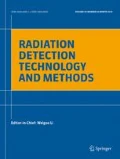Abstract
Purpose
A radiation detector’s sensitivity is important when designing survey plans. A measure of sensitivity is minimum detectable activity (MDA) which is the lowest amount of activity required for a signal to be distinguished above background. It has been known for some time that the efficiency of a moving detector can be improved by slowing the speed of travel. The Multi-Agency Radiation Survey and Site Investigation Manual describes but does not quantify this effect. Decreased efficiency at higher speeds results in higher MDAs and thus less sensitive detectors. The purpose of this research is to specifically define the relationship between detector MDA and speed.
Methods
Python was employed to calculate solid angle from equations developed by Masket and MCNP6.1 simulations were used to determine detection efficiency for a moving detector. Using these results efficiency as a function of detector travel speed was fit to a modified four-parameter logistic function (M4PL).
Results
The result of this work is a well defined relationship that can be used to predict MDA as a function of speed. The relationship can also be used by operators to determine the optimum speed needed to meet a predefined MDA.
Conclusion
Understanding this relationship between detector speed and efficiency will improve detector performance in remediation efforts and national security search operations. The M4PL function developed in this research allows optimizing remediation and wide-area radiation survey activities by setting maximum survey speed to meet a predetermined MDA.






Reprinted from Masket et al. [13]

Reprinted from Masket et al. [13]




Similar content being viewed by others
References
E.W. Abelquist, W.S. Brown, Estimating minimum detectable concentrations achievable while scanning building surfaces and land areas. Health Phys. 76(1), 3–10 (1999). https://doi.org/10.1097/00004032-199901000-00002
T. Alecksen, R. Whicker, Scan MDCs for GPS-based gamma radiation systems. Health Phys. 111(2), S123–S132 (2016). https://doi.org/10.1097/hp.0000000000000517
B. Altshuler, B. Pasternack, Statistical measures of the lower limit of detection of a radioactivity counter. Health Phys. 9(3), 293–298 (1963). https://doi.org/10.1097/00004032-196303000-00005
B. Ayaz-Maierhafer, T.A. DeVol, Determination of absolute detection efficiencies for detectors of interest in homeland security. Nucl. Instr. Methods Phys. Res. A 579(1), 410–413 (2007). https://doi.org/10.1016/j.nima.2007.04.143
L.-E. De Geer, Currie detection limits in gamma-ray spectroscopy. Appl. Radiat. Isot. 61(2–3), 151–160 (2004). https://doi.org/10.1016/j.apradiso.2004.03.037
T. Goorley, M. James, T. Booth, F. Brown, J. Bull, L.J. Cox, J. Durkee, J. Elson, M. Fensin, R.A. Forster, J. Hendricks, H.G. Hughes, R. Johns, B. Kiedrowski, R. Martz, S. Mashnik, G. McKinney, D. Pelowitz, R. Prael, J. Sweezy, L. Waters, T. Wilcox, T. Zukaitis, Initial MCNP6 release overview. Nucl. Technol. 180(3), 298–315 (2017). https://doi.org/10.13182/NT11-135
I. Holl, E. Lorenz, G. Mageras, A measurement of the light yield of common inorganic scintillators. IEEE Trans. Nucl. Sci. 35(1), 105–109 (1988). https://doi.org/10.1109/23.12684
G. Knoll, Radiation Detection and Measurement, 4th edn. (Wiley, New York, 2010)
G.H. Kramer, L.C. Burns, S. Guerriere, Monte carlo simulation of a scanning detector whole body counter and the effect of bomab phantom size on the calibration. Health Phys. 83(4), 526–533 (2002). https://doi.org/10.1097/00004032-200210000-00011
E. Lepel, B. Geelhood, W. Hensley, W. Quam, A field-deployable, aircraft-mounted sensor for the environmental survey of radionuclides. J. Radioanal. Nucl. Chem. 233(1–2), 211b–215 (1998). https://doi.org/10.1007/BF02389674
C. Marianno, Signal processing and its effect on scanning efficiencies for a field instrument for detecting low-energy radiation. Health Phys. 109(1), 78–83 (2015). https://doi.org/10.1097/HP.0000000000000298
C. Marianno, K. Higley, T. Palmer, Theoretical efficiencies for a FIDLER scanning hot particle contamination. Radiat. Protect. Manag. 17, 31–34 (2000)
A. Masket, R. Macklin, H. Schmitt, Tables of solid angles and activations. Department of Energy. Technical Information Service Extension, Oak Ridge, ORNL-2170 ed (1956)
R. Pöllänen, H. Toivonen, K. Peräjärvi, T. Karhunen, T. Ilander, J. Lehtinen, K. Rintala, T. Katajainen, J. Niemela, M. Juusela, Radiation surveillance using an unmanned aerial vehicle. Appl. Radiat. Isot. 67(2), 340–344 (2009). https://doi.org/10.1016/j.apradiso.2008.10.008
G. Rossum, Python 3.6.1 reference manual. Python.org [online] (2017). https://docs.python.org/release/3.6.1/. Accessed 23 May 2018
R.C. Runkle, T.M. Mercier, K.K. Anderson, D.K. Carlson, Point source detection and characterization for vehicle radiation portal monitors. IEEE Trans. Nucl. Sci. 52(6), 3020–3025 (2005). https://doi.org/10.1109/TNS.2005.862910
E. Sakai, Recent measurements on scintillator-photodetector systems. IEEE Trans. Nucl. Sci. NS-34(1), 418–422 (1987). https://doi.org/10.1109/tns.1987.4337375
G.S. Sittampalam, N.P. Coussens, K. Brimacombe, et al. (eds.), Assay Guidance Manual [Internet] (Eli Lilly & Company and the National Center for Advancing Translational Sciences, Bethesda, 2004)
U.S. Nuclear Regulatory Commission, Multi-agency radiation survey and site investigation manual (MARSSIM), revision 1. U.S. NRC, Washington; NUREG-1575 (2000)
G. Warner, R. Oliver, A whole-body counter for clinical measurements utilizing the shadow shield technique. Phys. Med. Biol. 11(1), 83 (1966). https://doi.org/10.1088/0031-9155/11/1/307
R. Whicker, P. Cartier, J. Cain, K. Milmine, M. Griffin, Radiological site characterizations: gamma surveys, gamma/226ra correlations, and related spatial analysis techniques. Health Phys. 95(5), S180–S189 (2008). https://doi.org/10.1097/01.hp.0000324206.39683.c4
Author information
Authors and Affiliations
Corresponding author
Ethics declarations
Conflict of interest
On behalf of all authors, the corresponding author states that there is no conflict of interest.
Rights and permissions
About this article
Cite this article
Falkner, J., Marianno, C. Modeling minimum detectable activity as a function of detector speed. Radiat Detect Technol Methods 3, 25 (2019). https://doi.org/10.1007/s41605-019-0103-5
Received:
Revised:
Accepted:
Published:
DOI: https://doi.org/10.1007/s41605-019-0103-5




